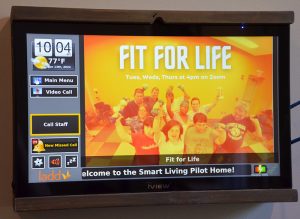LADD’s Smart Living program is about using technology to empower people with disabilities to live more independent, satisfying lives.
Smart Living is a new, innovative and more affordable way of delivering critical supports to adults with developmental disabilities living in the community. The system utilizes a multitude of integrated technology solutions, a customized dashboard and app that integrates multiple users’ data and a lean and nimble staffing model. Combined, these three components have the ability to disrupt the current service model and provide a new way of supporting people with developmental disabilities in our community.
Susan Brownknight, CEO of LADD, “Originally, we believed there were others tackling the trifecta of challenges: tech, staffing and affordability.
Smart Living allows an agency like LADD to utilize staff much more efficiently and effectively. Staff deploy when they are needed. The technology and remote staff are there in the back ground customized to a person’s day-to-day needs.
In-person staff are then able to provide specialized intervention that only a skilled and trained person can provide. In-person staff are also available when there is no viable tech solution.
The deeper we got into our pilot the more we heard and saw that the need for a leaner staffing model like ours. And, the more we heard about the desperate need for more affordable community integrated living options. And, so we are working like hell to accelerate the scaling of our Smart Living system.”
LADD’s Smart Living technology has already expanded to 44 sites, and the goal by end of 2022 is to have 100 people supported by Smart Living technology. All the technology is designed to increase health, safety, and independence. For the team developing and managing the Smart Living program, there are some incredible successes, some surprises, and some things that still need figured out:
Says Brownknight with regard to “successes,” “The support platform, which we took months to find and vet has turned out to have some solid attributes including voice and video chat that lets our support staff talk directly to the residents, sensors that detect movement through house – like pacing at night, and wearables that monitor heart rate to track stress.”
There have also been some genuine surprises. Per a Xavier University research study, the smart refrigerator has a return on investment of ten weeks. The refrigerator assists people in planning menus and grocery lists, sending the list directly to Kroger. It also tracks leftovers so you can adjust based on how much food you have left. “What I love about the fridge,” shares Susan, “is that it gives the power back over to the people receiving services, while also allowing remote staff to utilize data to support healthy decisions. For example, remote staff can recommend healthy meal options through the fridge app. when a person is meal planning.”
Another surprise for the team has been the smart toothbrush which monitors dental care. This readily available device ensures intervention happens only when/if it is needed, and it can be connected to other technology for broader health monitoring. Susan commented, “I’ve picked up the Oral B 10000 for my family too—it is really effective at teaching anyone how to brush.”
Finally Brownknight adds, “There are challenges. The single hardest thing has been figuring out how to take 100 pieces of tech and make them meaningfully work together. We have had to figure out how to ensure our Smart Living staff didn’t have five computer screens and four apps open at any given time monitoring thousands of data points.”
In addition to the home-based technology, LADD is also working on an app for smart watches and smart phones that can provide the same level of support when a person is out in their community. The beta technology includes video or voice chat, buttons to push that alert staff if you are lost or need help finding transportation, medication reminders, and even geo-fencing for safety.

Brownknight says, “We have people who have never been on a walk by themselves and now it is possible with the help of our Smart Living System. To see people utilize technology to achieve enormous life satisfaction and independence that would otherwise not have been possible; well, that is deeply satisfying.” Brownknight continues, “And, to hear when parents have taken a weekend trip successfully—just the two of them—I also find that extremely fulfilling. Parents have moved mountains for their children. To see them have a moment to exhale while their child is not only surviving, but thriving, that’s pretty special. All parents deserve such a moment.”
The next phase for the LADD team is to finalize the policy and procedure manuals and training materials so that LADD can scale Smart Living to other organizations throughout the country. Brownknight concludes, “LADD has worked hard to develop a new way of delivering services. We still have a lot to learn, but we have a vision to be able to bring our system to anyone who needs it. While Smart Living isn’t for everyone, our mission remains and we want all those that can use Smart Living to have the opportunity to live, work and connect here, in our community and in communities across the country.”

